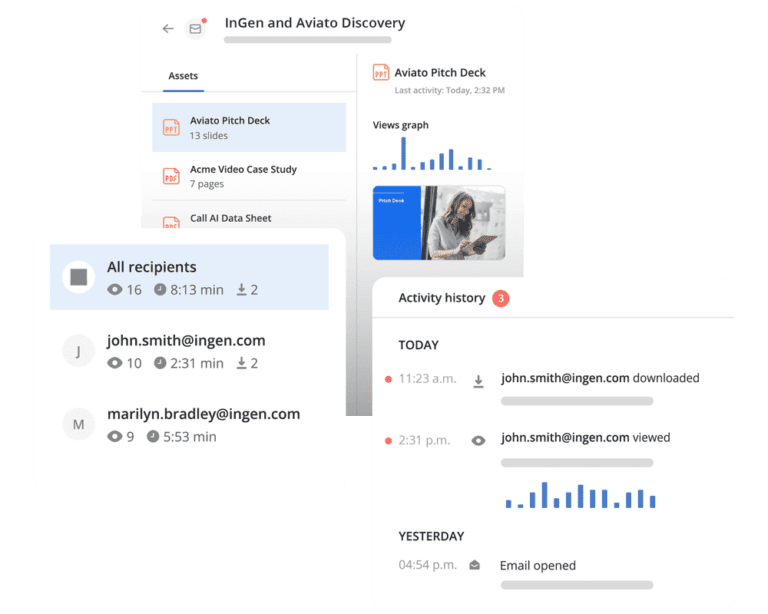To measure the success of your sales enablement program, you need to study more than just revenue and the number of units sold. Measuring sales enablement is about correlating sales activities with tangible business outcomes to discover what works and what doesn’t.
There are several effective ways to measure and track your sales enablement efforts. We’ll show you how each one works. Then you can pick the one best suited to your company’s needs.
Once you identify the best ways to measure your sales enablement program, you can start to make improvements, standardize activities, and develop successful sales enablement strategies.
Note: Each method is labeled direct or indirect. Direct ways of measuring sales enablement performance can be tied to revenue, while indirect ways can still impact the bottom line, but they’re not as immediate.
- Lead-to-opportunity conversion rate
- Win rate
- Competitive win rate
- Average deal size
- Quota attainment
- Sales process adherence
- Average time to productivity
- Time to quota
- Rep turnover rate
- Employer Net Promoter Score (NPS)
- Knowledge retention
- Content usage and adoption
- Call to action insights
1. Lead-to-opportunity conversion rate (direct)
Your lead-to-opportunity conversion rate tells you how often your salespeople convince your leads to stay in the sales funnel and potentially make a purchase. If your lead-to-opportunity conversion rate is high, your salespeople have the right skills, knowledge, and content to convince leads to consider buying your product or service.
How you track your lead-to-opportunity conversions depends on what you consider an opportunity. Opportunities have different specifications at different companies. A typical example of turning a lead into an opportunity is when a seller convinces a lead to attend a meeting or a demo. This scenario lets your company talk directly with your lead and move them through the sales funnel.
Track it in an Excel or Sheets spreadsheet or your CRM or sales readiness platform. Create a column for a list of leads and one for opportunities. At the end of each time period or cycle, pull a report from your CRM or sales readiness tool or use the formula below.
Take the number of opportunities divided by the total number of leads.
2. Win rate (direct)
Your sales win rate shows how often your salespeople convert opportunities into closed deals and gives you a gauge of individual sales rep performance and the abilities of your sales team(s) overall.
By looking at each rep’s win rate, you can tell whether or not they need more training or knowledge on how to convert. If the win rate of the team is consistently low, look into which practices aren’t working. For example, you may need to rethink your target customer, upskill all your sales reps, or review your marketing content.
Keep an ongoing record of your total number of opportunities and the number of those that turn into deals won. Track it in a spreadsheet or on your sales platform.
Create a column for a list of opportunities and one for wins. At the end of each sales cycle, pull a report using the win rate formula.
Take the number of wins your sales rep, sales team, or company has in a given month or quarter (sales cycle length) and divide it by the total number of opportunities.
3. Competitive win rate (direct)
This measurement is similar to win rate but only measures the rate of closed deals where your prospects (those who are in the opportunity stage) are also considered to be in a deal with a competitor.
If you have a lot of prospects who choose competitors, try to identify why they’re choosing competitors and use that info to equip your reps to close more of these deals. For example, if there’s a particular competitor your opportunities frequently choose over you, look at what they offer that you don’t. Or see what features their product or brand has that could be perceived as an advantage.
The ability to track your competitive win rate depends on whether or not prospects tell you that they’re considering purchasing from a competitor. You can make it part of your sales process to ask if they are, but they’ll have to voluntarily give you the information.
When you do get the information from your prospects, track it in a spreadsheet or on your sales platform. Make a column for a list of opportunities where the prospect considered working with a competitor and a column for how many were won. Then pull a monthly or quarterly report using the competitive win rate formula below.
Take the total number of team or company wins over a competitor and divide it by the total number of opportunities who considered a competitor.
4. Average deal size (direct)
This KPI tells you the average amount of money each customer spends on your product or service. Measure average deal size to identify patterns in the value of your deals. This can help you pinpoint better cross-selling and upselling opportunities for your salespeople.
To track average deal size, you need to log the amount of money each deal is worth and the number of deals closed. You can use a spreadsheet and the formula below to calculate the average deal size or pull a report from your sales platform.
Divide the total amount of money received from all customer orders in a given time frame by the number of deals you closed in that same period.
5. Quota attainment (direct)
Quota attainment is the percentage of your salespeople who are hitting their target sales goal during each sales cycle. In order for your team and your company to meet its quotas, each rep has to meet theirs. If you find you have team members who have trouble meeting their quotas, you can help them improve with coaching, training, and enhancing their knowledge.
At the end of each month, log the individual sales for all your sales reps. You can also compare each sales rep’s quota attainment to their performance in previous quarters or previous years to identify patterns. For example, maybe they performed better after they received training on a specific skill last year, and now they need a refresher course on that skill.
Use a spreadsheet or your sales platform. Make a column for their actual sales and one for their monthly quota. Use the formula below or pull a report from your CRM or revenue productivity platform.
For each salesperson, divide their actual sales in a given time period by their quota (or target sales) for that same period.
6. Sales process adherence (indirect)
This is a measurement of how well your sales process is adhered to by your sales reps. If you see your sales reps are not adhering to the process and also not meeting quotas, there may be a correlation. You can track this and find ways to get your reps to adhere to the process more closely.
Create a standard way for your reps to follow and document the process. For example, you could create a list of steps they can easily check off as they complete them. Or you can create a fill-in-the-blank template for the different steps of your process.
If your sales tool lets you track sales adherence (like with a checklist or template), you can use it to pull automatic reports. Otherwise, your sales managers will need to track and measure it manually using a spreadsheet.
This measurement requires some estimations based on company knowledge. To manually measure sales process adherence, you need a documented sales process — one that requires your sales reps to fill in or check off each step.
First, give each step of the sales process a weight. For example, if you have 10 steps, each step has a weight of 10%. If you have eight steps, each step weighs 12.5%.
Then, managers need to identify the percentage of steps each rep adheres to. (They have to refer to each rep’s documentation for this.) As an example, if your sales process has 10 steps and a sales rep adheres to seven, they adhere to 70% of the process.
7. Average time to productivity (indirect)
The average time to productivity is often referred to as ramp-up time, and it tells you the amount of time it takes for your newly hired sales reps to reach full productivity. Knowing the average time to productivity helps sales leaders make more accurate forecasts based on the capacity of each rep.
7. Average time to productivity (indirect)
The average time to productivity is often referred to as ramp-up time, and it tells you the amount of time it takes for your newly hired sales reps to reach full productivity. Knowing the average time to productivity helps sales leaders make more accurate forecasts based on the capacity of each rep.
Start by defining productivity. For example, maybe you define productivity as:
- Making [X] calls per day,
- Reaching at least [X]% of quota
- Successfully demonstrating relevant skills (like product knowledge and building rapport).
Once you define productivity, use a spreadsheet or your sales tool if it has the capability to run a report. Keep a quarterly log of how long it takes each sales rep to reach productivity and how many reps have finished ramping up.
Take the sum of the time to productivity for all reps who finished ramping up in a quarter and divide it by the number of sales reps.
8. Time to quota (indirect)
This key metric measures the amount of time it takes for your reps to reach their sales quota for the first time. It can tell you how effective your sales enablement onboarding is. If you see it takes longer for reps to meet their quota, you can pinpoint areas of your onboarding process that aren’t setting them up to succeed. For example, maybe the onboarding process needs to have more emphasis or focus on time management.
Keep track of how many sales cycles it takes for each of your reps to meet their quota for the first time from after onboarding. Pull a report from your CRM or sales tool using the formula below with a spreadsheet.
Take the sum of the number of sales cycles it takes for each rep to meet their quota after onboarding, then divide it by the number of reps you’re measuring.
9. Rep turnover rate (indirect)
Rep turnover rate measures how often your reps voluntarily leave your company for any reason. This can be indicative of a few things but, in general, a high turnover rate indicates a problem among your sales reps that needs to be identified and fixed.
To find out more from your reps who leave, conduct a voluntary exit interview. Ask questions related to preparedness and your sales enablement program to find out how effective they perceive it to be.
Use a spreadsheet or a human resource management system to track your rep turnover rate. Create a you can add to whenever a sales rep voluntarily leaves the company. Pull the report or use the formula below monthly or quarterly.
Take the number of reps who voluntarily left the company in a specific time period and divide it by your total number of sales reps.
10. Employee Net Promoter Score (indirect)
You may already be familiar with a Net Promoter Score, which helps you gauge your customer experience and how satisfied your customers are. Similarly, an employee Net Promoter Score lets you measure your employees’ experience and satisfaction with your company. The more satisfied your employees are, the less likely it is you’ll see high turnover.
To track your employee Net Promoter Score, use a survey tool like Google Forms or Survey Monkey. When you create the questions, frame each one so the answers are a number. For example, ask “On a scale of 1-10…” so you can use the numbers 1-10 as a range for measuring answers.
Then you’ll designate each rep as a promoter, passive, or detractor based on their score:
- Average of 9 or 10 = promoters: the rep is committed, satisfied, and engaged.
- Average of 7 or 8 = passive: they’re neutral and generally content but not fully committed.
- Average of 6 or less = detractors: they’re disengaged and probably won’t recommend your company to other job seekers.
After you’ve designated all your respondents in the appropriate category, take the number of promoters, subtract the number of detractors, divide that by the total number of respondents, and multiply this by 100.
11. Knowledge retention (indirect)
It’s not enough for sales teams to just understand the knowledge and content related to their jobs. Sales reps need to retain the information they learn so they can easily recall it for use during customer interactions.
The best way to track knowledge retention is by listening to interactions between your sales reps and customers. When you listen to customer phone conversations, you’ll be able to identify any gaps in sales reps’ knowledge.
You can use conversation intelligence software or take notes manually.
Take an assessment 30 days after initial sales training or consumption of knowledge. Use reinforcement activities like role-play or simulations where you mimic real-life sales scenarios in which they can use the knowledge they’ve acquired.
12. Content usage and adoption (indirect)
A big part of measuring sales enablement is tracking how well received and used related content is by your sellers and customers.
For sales teams, use a drive like Dropbox or Google Workspace to look at insights for your content. To track content adoption for customers, use Google Analytics or another website analytics tool.
Measure content adoption for your sales team and customers separately since they are two completely separate audiences.
To measure content adoption for customers, look at the number of views, how much time they spend on each piece of content, and/or the number of downloads.
To measure content adoption for sales teams, look at how often a piece of content is opened and used or shared.


13. Calls-to-action insights (indirect)
Calls-to-action (CTA) insights show you how often a potential customer takes action on your content, including blogs, paid ads, emails, and more. The more your leads click on your content to learn something or take an action, the more effective the content is.
You can compare whether the actions taken on your content correlate to more leads or more opportunities won by your sales reps.
You may need to use multiple tools to measure your CTAs, depending on how you distribute your content. For example, if you use Mailchimp for your email marketing and Google Ads for your paid advertising, you’ll need to individually track the CTAs for each one.
When you look at CTA insights, the number of clicks tells you the most. The content with the most clicks means that it resonated most with your audience and made them want to learn more or take some other action with your brand.
For a complete overview of your sales performance, take a holistic approach to revenue enablement
These 13 sales enablement metrics let you look at all the components of your program to measure how well each is working and the effect it has on your overall business outcomes. But it’s more than just looking at the components. You need to be able to analyze the data and information so you can make improvements.
Mindtickle lets you track, measure, and improve your sales enablement program holistically by emphasizing a focus on all aspects of the process. Our platform helps you keep your content up-to-date, analyze seller behaviors and skills, continuously provide sales training to get your teams ready to drive growth, and create a foolproof sales enablement strategy. Want to learn more?
Start measuring what matters with Mindtickle
Create a foolproof sales enablement strategy. Want to learn more?
Get a DemoThis post was originally published in August 2022 and was updated in November 2023.








